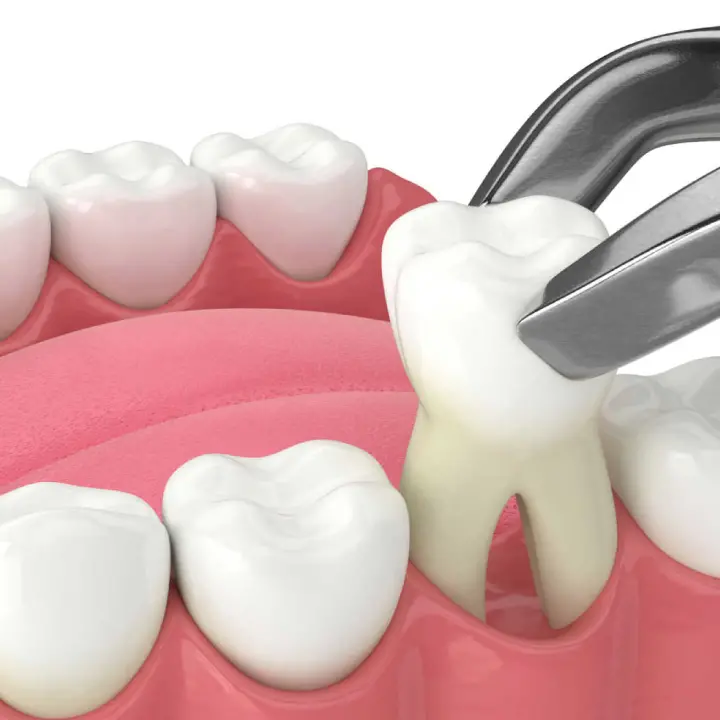
Tooth extraction available near you
Preparing for a tooth extraction
Tooth extraction procedure: what to expect before, during and after.
Before your tooth extraction
Your dentist will assess your affected tooth and surrounding gums, take dental X-rays to check bone levels and determine the extent of damage. Be sure to tell your dentist about any medications, vitamins, or supplements you’re taking. Once all information is gathered, treatment and sedation options will be discussed with you in detail.
Before your scheduled tooth extraction, you should:
What are my sedation options in dentistry
Sedation is an excellent option for people who have dental anxiety — or for those who simply want to be more comfortable during their appointment. Sedation medications used in dentistry include:
- Nitrous oxide. Known as “laughing gas,” nitrous oxide is a gas that you inhale through a mask or nosepiece. It’s a good option for people who need light level sedation. People who choose nitrous oxide can drive themselves to and from their appointments.
- Oral conscious sedation. This type of sedation is given by mouth, usually in pill form, about an hour before your dental appointment. Oral conscious sedation can be used on its own or in combination with nitrous oxide or intravenous sedation. People who choose oral conscious sedation will need a friend or family member to drive them to and from their appointment.
- Intravenous (IV) sedation. This is recommended for people with significant dental anxiety or for those undergoing lengthy procedures. Sedative and pain medications are delivered directly to your bloodstream using an IV line. IV sedation is the highest level of sedation that can be obtained in a dental office setting. People who choose IV sedation will need to make arrangements for a driver the day of their procedure.
What happens during a tooth extraction?
First, local anesthesia is given to numb your affected tooth and surrounding gum tissue. Using specialized dental instruments, your dentist will gently loosen your tooth and carefully lift it from its socket.
Sometimes, your dentist might need to make incisions in your gums to access your tooth — especially if your tooth is badly decayed or has broken off at the gum line.
Once your tooth is removed, the socket is cleaned and disinfected.
In some cases, your dentist may also place a dental bone graft, which helps prevent bone loss in your jaw. Finally, stitches may be placed to help promote healing.
What happens after a tooth extraction?
When the procedure is complete, your dentist will place a piece of gauze over the extraction site and ask you to close down with firm, steady pressure. This helps slow bleeding so a blood clot can form. (Clotting is a normal aspect of recovery. It promotes healing and reduces the risk of dry sockets.) You’ll take the gauze out once the bleeding has slowed enough. You may continue to have light bleeding throughout the first 24 hours.
Tooth extraction healing
First 24 hours
- Get plenty of rest and limit physical activity.
- Stick to a diet of liquids and soft foods.
- Do not use a straw, smoke, or suck on candy or lollipops. The sucking motion can disturb the clot that is forming at the extraction site.
- Avoid drinking hot liquids or alcohol or using mouthwash that contains alcohol.
- Apply an icepack or cold, damp washcloth to your face to help reduce swelling.
Day 2
- Add other foods to your diet as tolerated.
- Chew on the opposite side of your mouth as the extraction. After a few days, gradually begin to chew on both sides.
- Begin cleaning the teeth next to the extracted tooth site.
- Gently rinse your mouth with saltwater after meals to help keep the healing tooth socket clean.
- Resist playing with the healing gum, which could disrupt the clot and cause a dry socket. A dry socket can cause severe pain and lead to other complications.
When to call your dentist
Call your Celebrate Dental & Braces office immediately if you experience any of the following:
✓ Signs of infection, like fever and chills
✓ Bad breath or taste in your mouth
✓ Nausea or vomiting
✓ Severe pain, swelling or bleeding
✓ Cough, shortness of breath or chest pain
✓ Pain that gets worse after the procedure
Your tooth extraction questions answered
Can I eat solid food after a tooth extraction?
After tooth extraction, we recommend waiting at least 24 to 48 hours before reintroducing solid foods to make sure your mouth has had enough time to heal.
What to eat after a tooth extraction?
Post-tooth extraction, it’s best to choose soft foods that are easy to eat. A few great selections are applesauce, yogurt, mashed potatoes, and soup. While your mouth is healing, it’s best to avoid eating anything hard, spicy, or crunchy.
When to stop using gauze after an extraction?
Follow your dentist’s instructions when it comes to your unique recovery. But typically, you can expect to stop using gauze once the bleeding subsides. This can be a few hours post-extraction.
How long does an extraction take?
Tooth extraction duration varies patient to patient. But it’s safe to say that simple extractions usually take between 20 to 40 minutes, with more complex extractions taking longer.
Why no dairy after a tooth extraction?
Avoiding dairy post-tooth extraction reduces the risk of bacterial growth and infection, especially 48 hours post-procedure.
What are the advantages of pulling a tooth?
Tooth extraction offers a number of benefits. Most importantly, it reduces harmful bacteria that can damage your teeth and gums. Left untreated, a decayed or damaged tooth can wreak havoc on your smile, causing a domino effect of problems. Removing your affected tooth gives you the best chance for optimal oral health. Additionally, a tooth extraction can help ease dental pain almost immediately — especially if your tooth was severely broken or infected.
What are the risks or complications of tooth extraction?
Like any surgical procedure, tooth extraction carries a small risk of complications. These may include:
- Post-surgical infection.
- Dry socket.
- Nerve injury.
- Perforation of maxillary sinus.
- Delayed healing.
What are the side effects of removing a tooth?
Normal side effects following tooth extraction include bleeding, swelling and discomfort. Your dentist will provide instructions on how to successfully manage your healing.
How long does it take to recover from a tooth extraction?
It depends on the complexity of your case. However, most people feel back to normal in just a few days. While you can return to routine activities within 48 to 72 hours, it usually takes several weeks to heal the jawbone. Therefore, if you plan on replacing the tooth with a dental implant, you’ll probably need to wait a few months for full recovery.
How long does it take to recover from a tooth extraction?
It depends on the complexity of your case. However, most people feel back to normal in just a few days. While you’ll be able to return to routine activities within 48 to 72 hours, it usually takes the jawbone several weeks to heal completely. Therefore, if you’re planning on replacing the tooth with a dental implant, you’ll probably need to wait a few months to allow for full recovery.
Medical references and resources
- Tooth Extraction: Procedure, Aftercare & Recovery – https://my.clevelandclinic.org/health/treatments/22120-tooth-extraction
- Tooth Extraction: Cost, Procedure, Risks, and Recovery – https://www.healthline.com/health/tooth-extraction
- Tooth extraction: MedlinePlus Medical Encyclopedia – https://medlineplus.gov/ency/article/007630.htm
- Dental extraction – https://en.wikipedia.org/wiki/Dental_extraction
- Tooth extraction: Procedure, costs, and what to expect – https://www.medicalnewstoday.com/articles/327170
- Extractions | MouthHealthy – Oral Health Information from the ADA – https://www.mouthhealthy.org/all-topics-a-z/extractions
- Oral Surgery, Extraction of Teeth – StatPearls – NCBI Bookshelf – https://www.ncbi.nlm.nih.gov/books/NBK589654/
- Tooth Extractions and Info on Tooth Extraction Healing – https://www.aspendental.com/dental-services/tooth-extraction/
Medically reviewed by
#AUTHOR
#DATE
#COPYRIGHT
Discover more for your smile
Caring for you throughout your tooth extraction
Still have questions about what to expect before, during and after your procedure? We’re here to help—and walk you through it every step of the way.
Our Doctors’ Affiliations







